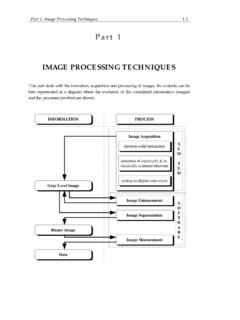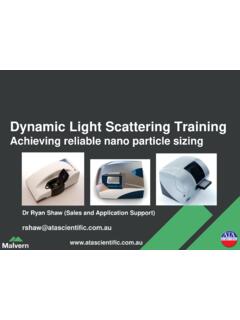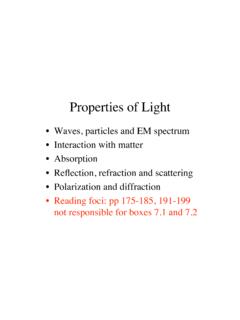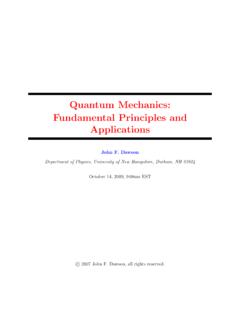Transcription of Rutherford Scattering of α-Particles
1 Rutherford Scattering of -Particles Emily P. Wang . MIT Department of Physics (Dated: December 8, 2004). The Scattering of -particles off of gold foil was investigated. Attenuation of the -particle beam was used to measure the thickness of the gold foil used. The coefficient of the Rutherford differential Scattering cross section was experimentally determined to be ( ) 10 25 cm2 , compared to 10 24 cm2 , with a reduced chi-squared of , which is a reasonable fit and confirms the accuracy of the Rutherford model of the atom. 1. INTRODUCTION 2. DIFFERENTIAL Scattering CROSS.
2 SECTION OF NUCLEI. When Geiger and Marsden first began Scattering ex- For a single scatterer, such as a single gold nucleus periments involving alpha particles and thin metal foils, within a thin gold foil layer, the differential Scattering scientists knew little about the structure of the atom. cross section is defined as follows [2]: The charge to mass ratio of the electron was known with reasonable accuracy, and it was also known that most of d ( , ) flux scattered into element d at angles ( , ). =. the mass in an atom was due to the positive charge. The d incident flux per unit area dilemma faced by scientists was understanding how the positive and negative components of the atom were held where is the Scattering cross section of a single nucleus.
3 Together, and how they managed to create the regular To obtain the differential Scattering cross section, one can phenomena that had been observed, such as the combi- make measurements of the intensity I of the beam when nation rules and series limits for the complex spectra of alpha particles are scattered through certain angles and multi-electron atoms. calculate as follows: d I A. Drawing upon Newtonian mechanics and Maxwell's = (1). electromagnetic theory, J. J. Thompson formulated the d d I0 NAvo xf oil plum-pudding model of the atom. In this model, where NAvo is Avogadro's number, xf oil is the thickness the atom consisted of a spherical pudding of positive of the target foil, A is the atomic mass of the material in charge, and electrons were distributed throughout the the target foil, d is the solid-angle of the detector, I0 is atom, much like raisins in a pudding.
4 The drawbacks of the unattenuated intensity of the alpha particle beam. the plum-pudding model was that it yielded no explana- Using classical mechanics to calculate the effect on al- tion for the quantized nature of the hydrogen spectrum, pha particles as they approached atomic nuclei, Ruther- as expressed by the Balmer formula and the Ritz combi- ford derived an equation to describe the Scattering of nation principle for atomic spectra. particles at large angles, where Scattering is mostly due Rutherford came upon the idea of probing the struc- to a single Scattering event rather than multiple small an- ture of atom by firing -particles, or helium ions, at thin gle Scattering events.
5 Laborious experiments conducted metal foils. The experiments conducted by Rutherford by Geiger and Marsden found this equation to hold true. and his collaborators Geiger and Marsden lead to a rev- The equation is as follows [3]: olution in the model of atomic structure. If, the plum- pudding model had indeed been correct, then the fraction d ZZ 0 e2 2 1. of particles scattered through an angle of or greater =( ) (2). should have been observed to fall off like a Gaussian. d 4E sin4 ( 2 ). This description was found to be accurate for small an- where Ze is the charge of the target nuclei, Z 0 e is the gle Scattering , but not for large angles of Scattering [1].
6 Charge of the alpha particles, and E is the kinetic energy The goal of this experiment was to reproduce Ruther- of the alpha particles. ford's experiment with thin metal foils by Scattering al- pha particles through a gold foil. Experimental data was compared to the theoretical model of Rutherford scatter- 3. SOLID-STATE DETECTORS. ing. Solid-state dectectors hold several advantages over their gas-filled counterparts. One advantage is the greater resolution and better statistics possible, due to Electronic address: the fact that lower energy is needed for the creation of 2.
7 1. 0 00. 11 0. 1. 010. 011. 0000. 11 00. 11 01. 1 01 01 11. 000. 100. 11 0. 1. n-p Junction (with Bias Voltage) Solid-State 100. 1100. 11 00. 11 0. 1 0. 1 0. 1 0 00. 110. 100. 11 00. 11. 0 1. 1 0. 1 Preamplifier Detector Voltage Limiter 0. 100. 1100. 11 00. 11 0. 1 0. 1 0. 1 0. 1 00. 110. 100. 11. 011. 10000. 11 00. 11 0. 1 0. 1 0. 1 0. 1 00. 110. 1. 011. 00. 00. 1100. 11 00. 11 00. 11. 00100. 11. 000. 111. 0000. 1111. 000. 111. Oscilloscope Bias Voltage . 0011. 1100 00. 11 11 000. 111. 0000. 1111. 000. 111. Amplifier Vacuum High Voltage 00. 11. Electrons 00.
8 1100. 1100. 1100. 11 000. 111. 0000. 1111. 000. 111. chamber 0. 100. 1100. 11 00. 1100. 1100. 1100. 1100. 11. Holes 00. 11. 000. 111 00. 11. 0000. 1111. 000. 11100. 11. 0. 100. 1100. 11 00. 1100. 1100. 1100. 1100. 11 0. 1 00. 11. 00. 1100. 11. 000. 111. 0000. 1111. 000. 11100. 110. 1. Target foils 011. 10000. 11 00. 1100. 1100. 1100. 1100. 11 0. 1. 01. 0 00. 11. 00. 1100. 11. 000. 111. 0000. 1111. 000. 111 0. 1. Alpha-particle 00. 1100. 1100. 1100. 1100. 11 10. 1 00. 11. 00. 1100. 11 00011. 000. 111 00. 0000. 1111. 111. Multi-Channel source 00. 1100. 11 001. 110 Analyzer 241Am Depletion Zones # holes n p n p FIG.
9 2: Setup of equipment used for both open-aperture and attenuated beam measurements, as well as angular depen- # electrons dence of differential Scattering cross section. The vacuum chamber was maintained at approximately 200 microns, or FIG. 1: The upper two images show an n-p semi-conductor 10 3 torr junction before and after bias voltage is turned on. The lower two images show the depletion zone in each case note that the depletion zone length is increased with the addition of vacuum chamber with a clear plexiglass cover weighted bias voltage. Figure adapted from [4] down with lead bricks (in order to ensure the o-ring along the rim of the vacuum chamber achieved a good seal).
10 With the bias voltage on the silicon barrier de- electron-ion pairs. Another advantage is the greater stop- tector turned down, the air was then pumped out of the ping power of the solid-state detector, which allows the cylindrical vacuum chamber. After the pressure in the detection of particles with energies characteristic of nu- chamber was on the order of 200 microns, the lead bricks clear interactions [4]. As the alpha particle beam was were removed from the plexiglass cover and a thick black to be interacting with the nuclei of atoms in this exper- cloth sheath was placed over the vacuum chamber.
















